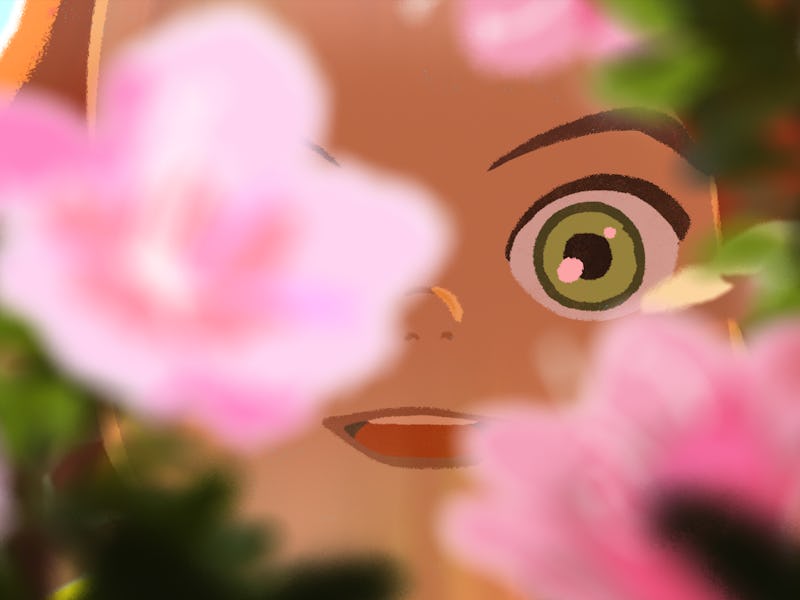Little Amélie Or The Character Of Rain Is A Metaphysical Wonder
The stunning French animated movie is a lovely slice-of-life drama.

There’s something different about Amélie. You see, she’s actually God. No matter that she’s barely three years old and has spent the majority of her life in a near-vegetative state. She has the power to bend reality and the world around her. Take, for instance, the moment when she turns three and finally snaps out of her “plant-like” silence: An earthquake shakes the entire Japanese house that she and her family live in, and suddenly Amélie (voiced by Loïse Charpentier) begins to cry. It’s as if the life bubbling underneath the surface of her stoic exterior forced its way out with such explosive force that it shook the whole world. And it certainly shakes her parents’ world. Because once Amélie starts crying, she doesn’t stop. She bawls and throws tantrums, enraged that she, a sophisticated and mature god, is bound to a body that cannot speak or move how she wants it to.
Amélie’s reign of terror is so destructive that her exhausted parents take the suggestion of their stern landlady, Kashima-san, to hire help. And soon, the gentle Nishio-san (voiced by Victoria Grosbois) arrives to help clean the house and cook for the family of Belgian expats living in Japan. But nothing really helps the situation with Amélie until her grandmother Claude (Cathy Cerdà) comes to visit, bearing something truly amazing: white chocolate. As soon as she gives a weeping Amélie the chocolate, Amélie’s eyes suddenly open wide and start to sparkle. This is it! The answer to life is white chocolate. Immediately, Amélie is calm, even pleasant. And she also, soon, can speak. It’s a series of apparent miracles that seem to unfold through the course of Little Amélie Or The Character Of Rain, itself a miraculous little animated film about the wonders of discovering life.
Based on the semi-autobiographical novel The Character of Rain (Métaphysique des tubes) by Amélie Nothomb, Little Amélie is a stunning achievement of animation from directors Maïlys Vallade and Liane-Cho Han. Its rather fantastical premise is based on the Japanese belief that until the age of three, children are gods, or okosama (meaning literally, “lord child”) until their third birthday when they fall from grace and join the reset of the human race. Little Amélie seeks to depict this literally, following a young girl who slowly loses her god-like powers (be they real or imagined) as she becomes increasingly self-aware. She discovers water, in a nearby pond and in the rain that falls from the sky. She discovers carp, which she becomes enchanted with and disgusted by. She discovers the concept of sadness, as she learns about the devastating loss that her beloved Nishio-san, who becomes her closest caretaker and friend, suffered during the war. And lastly, and most tragically of all, she learns about death.
Each new revelation is earth-shattering for little Amélie, who doesn’t take well to learning how hard and tough the world is. She once was a god, who could make the flowers bloom simply with her laughter. And now she must simply deal with the fact that people die, and that war exists and leaves the survivors scarred forever. It’s an upsetting lesson for anyone to learn, much less a three-year-old, and Little Amélie treats it like the world-ending experience that it is.
Nishio-san shows Amélie how to write her name in Japanese.
Vallade and Han achieve this feeling through breathtaking feats of animation. The pair had worked together on high-profile Gallic animation projects like The Little Prince, The Illusionist, and I Lost My Body, and you can see the result of all those past works in Little Amélie. A stunning piece of 2D animation, it’s like a watercolor tapestry merged with Japanese woodblocks, full of pastels that leap and glide across the screen. It’s got all the brightness and beauty of a child experiencing the world for the first time. And even as Little Amélie starts to explore darker topics, it never loses that airiness.
Little Amélie is a metaphysical wonder. It’s lovely and light and uplifting, and is full of an awe for life. And while it may not make you believe in god, it does make you believe in the power of animation.